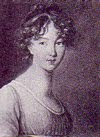Figure (1856)
John Dawson Watson
(1832-1892)
English
Oil on wood
Atkinson Art Gallery Collection, Southport, Merseyside,
England
I like this painting for many reasons. The details of the
girl’s clothing and hair, the lush green in the background, the cloudy weather,
and, most of all, that very intriguing piece of knitting, which, with its
bright colours, leaps out of the painting. So much so for the knitting, that I
searched through my stash and found similar colours of wool as I just had
to recreate that piece of work.
What is she knitting though? It seems to be a long bag or
sack, knitted in the round, in a pale custard yellow, red, blue, cream or
undyed natural light coloured wool and a dark brown or grey natural, undyed
wool. Could it be a long workbag or a storage bag for wool, not yet carded or
skeined or rolled into one of those very large balls at her feet? Even that is
odd as in many paintings I have mostly seen (but not always) wool wound into
smaller balls, the size of a large orange or smaller, sitting on laps, in
workbaskets, rolling on the floor, etc. The one in this painting is such a
gorgeous, loosely wound shape, barely even a ball.
Was the bag be intended as a market wallet but with only one
end open? Or was it to be a long snap sack, with a belt or strap
attached later?
Just how long this bag was going to be, we do not know. I
knit an eyelet row, with a hem of four more rows and then the cast/bind off
row, for threading a ribbon or cord through for closing. The finished length is
29 ½” and the width is 16” around.
The needles in the painting are double pointed and look
homemade or well used, one with a distinct curve to it. I can only see three
needles – perhaps one is tucked under her arm, although they are rather short
for that but then the girl is young and small. The work is also bunched
together in her hands, rather than having the needles splayed – the whole
technique portrayed with more artistic license than a comfortable method of
knitting.

I have studied and studied several images of this painting
that are available on the web. The stitches seem very large, too large for the
size of needles being used unless the girl was a very loose knitter. Based on
her physical dimensions, I estimated the size of each section by colour, and
experimented with several sizes of needles to get a loose gauge but not overly
loose so as to sag or be too lacy. Even so, I probably have at least twice as,
if not more, rows per section in my version.
This bag was knit on 5.5mm/US 9 sized needles using Brown
Sheep Nature Spun Worsted in Winter Blue, Natural,
Red Fox, Charcoal, and Lullaby.
{Please read the comments attached to this post.}










